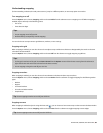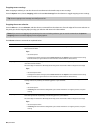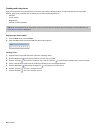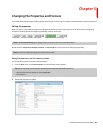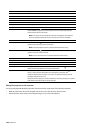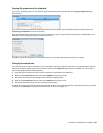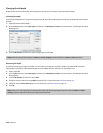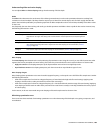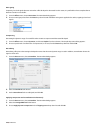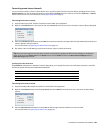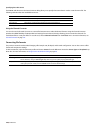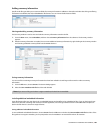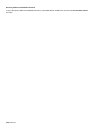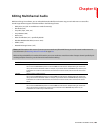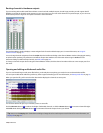
Understanding dither and noise shaping
You can adjust Dither and Noise shaping settings when decreasing a file’s bit depth.
Dither
The Dither value determines the randomness of the dither (generated noise) used to mask quantization distortion resulting from
conversion to a lower bit depth. This drop-down list requires you to select from several shapes, each of which roughly describes the
pattern that would be produced if you plotted a graph with the dither amplitude on the X-axis and the probability of the dither values
on the Y-axis.
As is frequently the case when working with audio, you should experiment with dither values to yield the best results. However, keep
the following information in mind:
Setting Description
Half Rectangular Eliminates distortion resulting from conversion to a lower bit depth, but the noise level is more likely to be
dependent on the signal. This setting uses a maximum dither noise amplitude of 0.5 LSB (least significant
bit).
Rectangular Identical to Half Rectangular, but with a maximum dither noise amplitude of 1 LSB (least significant bit).
Triangular Eliminates distortion products as well as any noise floor modulation, but results in a slightly higher noise
level. The option typically works well in conjunction with noise shaping. For more information, see Noise
shaping on page 103.
Highpass Behaves like triangular dither, but shifts its noise into higher frequencies. This is typically the best option
Triangular when used in conjunction with noise shaping. For more information, see Noise shaping on page 103.
Gaussian Does not perform as well as Rectangular and Triangular dither, but may be suitable for certain audio.
Noise shaping
The Noise shaping value determines the aural positioning of quantization noise. Using this control, you can shift the noise into audio
registers that are less perceptible to human hearing. This lowers the perceived noise floor and creates the illusion of cleaner audio.
• High-pass contour noise shaping attempts to push all quantization noise and error into high frequencies.
• Equal-loudness contour noise shaping attempts to push the noise under an equal-loudness type of curve.
Noise shaping dangers
Noise shaping places quantization noise near the audio’s Nyquist frequency, a value equal to one-half of the file’s sample rate. Consider
the following information:
• A file with a sample rate of 44.1 kHz has a Nyquist frequency of 22.05 kHz (at the high end of human hearing). Applying noise
shaping to this file results in audio perceived to be cleaner than it actually is.
• A file with a sample rate of 22 kHz has a Nyquist frequency of 11 kHz (well within the sensitive range of human hearing). Applying
noise shaping to this file results in audio that is perceived to be noisier than it actually is. Ironically, this defeats the entire purpose
of noise shaping.
For this reason, we do not recommend using noise shaping on files with sample rates less than 44.1 kHz.
Minimizing quantization error
There are at least three methods of minimizing quantization error when decreasing a file’s bit depth: noise gating, compression, and
normalization.
CHANGING FILE PROPERTIES AND FORMATS | 103



